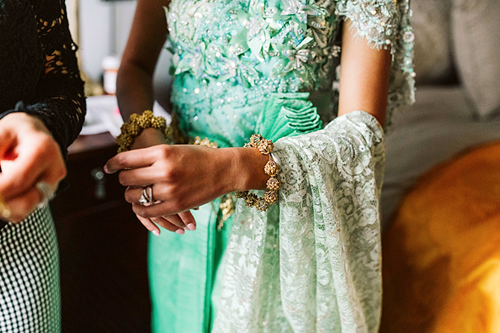A marvelous landlocked country in Southeast Asia, Laos boasts an abundance of stunning mountainous landscapes and enigmatic cultural sites. But what makes this nation stand out in authenticity is its cherished and well-preserved practices. In particular, the unique traditional marriage customs of the country.
Laotian traditional wedding ceremonies have been around for generations and essential for younger generations to pass it down. A Laos wedding ceremony, or “Suu Khwan”, is full of traditions involving the entire village or community.

“Sou Khor” Procession
Before setting the wedding date, both families of the couple must participate in a “Sou Khor” procession, in which they have to agree with each other on the bride’s price. The price serves as a refund for the effort the parents spent in raising the bride. Usually, the price depends on the social status of both sides.
Choosing the Lao Wedding Date

Laotians believe that the wedding date directly affects the prosperity and happiness of the bride and groom. To decide the best day for the wedding, the parents of both sides typically consult senior monks. The monks choose the day they expect to bring luck and happiness to the couple.
“Oun Dong” Ceremony
In the evening before the wedding, Laotians hold an informal ceremony called Oun Dong An. Relatives and close friends typically come to the bride’s house to help prepare Pha Khuan (a handmade marigold pyramid made of banana leaves and flowers), the food for the big day and decorate their new bedroom.
The Laotian Wedding Ceremony

According to tradition, it is custom for the bride to wear a traditional Sink (Lao skirt), a silk blouse, and many jewelry items. For the groom, it is a tradition to dress up in a silk Salong (Lao pants) and a white silk shirt. Traditionally, Laos people often hold a Baci ceremony in the morning of the wedding date.
Baci Ceremony

A Baci ceremony is a ritual that involves tying strings around a wrist to preserve good luck during special events. On wedding occasions, the Baci includes a chanting by the Mor Phon (the master of ceremony), an egg feeding, and the tying of white strings on the wrist. Then, the parents, relatives of both sides, and guests will take turns doing this.
Bride’s Price Giving Procession
After the Baci ceremony, the groom will give the bride’s price to her parents. After this exchange, the groom does an hae keuy, where they will walk to the house of the bride while singing, dancing, and playing musical instruments along the way. Upon arrival, the groom has to drink with the bride and go through a silver door and gold door. The groom must answer questions and pay money to open the door. Then, the little sister or any girl younger than the bride will wash his feet before letting him enter the house.



